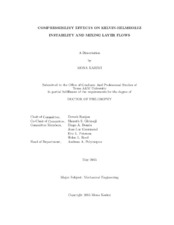| dc.contributor.advisor | Girimaji, Sharath S | |
| dc.contributor.advisor | Ranjan, Devesh | |
| dc.creator | Karimi, Mona | |
| dc.date.accessioned | 2017-08-21T14:29:38Z | |
| dc.date.available | 2017-08-21T14:29:38Z | |
| dc.date.created | 2015-05 | |
| dc.date.issued | 2015-06-05 | |
| dc.date.submitted | May 2015 | |
| dc.identifier.uri | https://hdl.handle.net/1969.1/161262 | |
| dc.description.abstract | The objective of the thesis is to analyze, understand and explicate the various physical mechanisms underlying the suppression of instability and mixing in compressible mixing layers. The investigation comprises of three studies which employ linear analysis and Direct Numerical Simulation (DNS). The first study examines the effect of compressibility on the underlying planar Kelvin-Helmholtz (KH) instability. The transformative influence of compressibility on the ubiquitous free shear-flow instability is investigated. This study focuses on the change in the character of pressure from a Lagrange-multiplier in incompressible flows to a thermodynamic variable in compressible flows. Linear analysis reveals that compressibility engenders the formation of a dilatational-interface-layer (DIL) within which the velocity perturbation is wave-like rather than vortical. Inherently unsteady dilatational action is shown to disrupt vortex merging and roll-up leading to suppression of KH instability. The second study examines the effect of perturbation alignment and non-linear interaction on the stability of compressible mixing layers. Linear analysis clearly shows that compressibility effects diminish with increasing obliqueness of the perturbation with respect to the shear plane. Notably, spanwise perturbations are impervious to Mach number effects. The non-linear effects are examined using DNS. It is shown that triadic interactions among the perturbation wavemodes lead to new perturbation wavemodes that are aligned closed to the spanwise directions and hence unstable. The third study examines mixing layer flow structure at various Mach numbers. At low speeds, the mixing layers exhibit strong spanwise rollers and short streamwise ribs. The effect of Mach number on the evolution of structures and the interaction between them are investigated in detail. With increasing Mach numbers, the spanwise rollers are suppressed. In the absence of spanwise rollers, the streamwise ribs align to form streamwise structures. | en |
| dc.format.mimetype | application/pdf | |
| dc.language.iso | en | |
| dc.subject | kelvin-Helmholtz instability | en |
| dc.subject | comressible mixing layers | en |
| dc.subject | shear flows | en |
| dc.subject | comressibility | en |
| dc.title | Compressibility Effects on the Kelvin-Helmholtz Instability and Mixing Layer Flows | en |
| dc.type | Thesis | en |
| thesis.degree.department | Mechanical Engineering | en |
| thesis.degree.discipline | Mechanical Engineering | en |
| thesis.degree.grantor | Texas A & M University | en |
| thesis.degree.name | Doctor of Philosophy | en |
| thesis.degree.level | Doctoral | en |
| dc.contributor.committeeMember | Donzis, Diego A | |
| dc.contributor.committeeMember | Guermond, Jean-Luc | |
| dc.contributor.committeeMember | Petersen, Eric L | |
| dc.contributor.committeeMember | Reed, Helen L | |
| dc.type.material | text | en |
| dc.date.updated | 2017-08-21T14:29:38Z | |
| local.etdauthor.orcid | 0000-0001-5858-4430 | |


